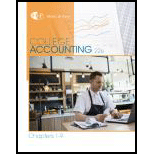
Block Foods, a retail grocery store, has agreed to purchase all of its merchandise from Square Wholesalers. In return. Block receives a special discount on purchases. Over recent months, Square noticed that purchases by Block had been falling off. At first, Square simply thought that business might be down for Block and was hopeful that their purchases would pick up. When business with Block did not return to a normal level, Square requested financial statements from Block. Squares records indicate that Block purchased $300,000 worth of merchandise during 20-1, the most recent year.
Selected information taken from Block's financial statements is as follows:

REQUIRED
Compute net purchases made by Block during 20-1. Does it appear that Block violated the agreement?
Trending nowThis is a popular solution!

Chapter 14 Solutions
College Accounting, Chapters 1-9 (New in Accounting from Heintz and Parry)
- How much long-term debt did the firm have?arrow_forwardSybarix Group prepared its financial statements for 2015 based on the information below. The company had cash of $1,206, inventory of $14,290, and accounts receivables of $6,589. The company's net fixed assets were $42,412, and other assets were $2,822. It had accounts payable of $11,580, notes payable of $2,886, common stock of $21,800, and retained earnings of $14,368. How much long-term debt did the firm have? a. $12,314 b. $16,685 c. $18,334 d. $22,342arrow_forwardGeneral accountingarrow_forward
 College Accounting, Chapters 1-27AccountingISBN:9781337794756Author:HEINTZ, James A.Publisher:Cengage Learning,
College Accounting, Chapters 1-27AccountingISBN:9781337794756Author:HEINTZ, James A.Publisher:Cengage Learning, EBK CONTEMPORARY FINANCIAL MANAGEMENTFinanceISBN:9781337514835Author:MOYERPublisher:CENGAGE LEARNING - CONSIGNMENT
EBK CONTEMPORARY FINANCIAL MANAGEMENTFinanceISBN:9781337514835Author:MOYERPublisher:CENGAGE LEARNING - CONSIGNMENT

